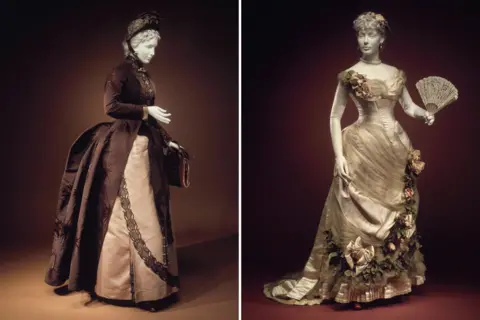
Chicago History Museum/Getty Images
Recognized as the “father of haute couture,” Charles Frederick Worth stands as one of fashion’s most significant pioneers. He is credited with the introduction of live models, the concept of fashion collections, and the practice of tagging clothing with labels.
Emerging from modest origins in Bourne, Lincolnshire, he transformed women’s fashion while amassing considerable wealth, becoming the preferred designer for royals and celebrities, setting the stage for future fashion icons like Christian Dior, Yves Saint Laurent, and Coco Chanel.
His birthplace is gearing up to commemorate the 200th anniversary of his birth.
“He became the premier designer of his time, recognized as the authority on fashion who influenced the modern fashion landscape,” remarks Prof Amy De La Haye, curator at the London College of Fashion and co-author of The House of Worth, Portrait of an Archive.
“For a time, he was the most renowned and esteemed designer globally.”

Public domain
Notable figures, including Queen Victoria and Empress Eugenie of France, frequented his salon, alongside prominent actresses and singers like Lillie Langtry and Nellie Melba.
The name Worth symbolized opulence as he and his over 1,000 employees worked tirelessly to reshape the fashion realm.
Despite his staggering journey, his humble beginnings foreshadowed none of this success.
Having been born in October 1825, Worth was only 11 when he began working after the family’s financial downfall, which left his father to flee the household.
In his role at a haberdashery owned by Jemima Todd, he was known for “trimming bonnets to bring smiles to the ladies of Bourne”, per local history enthusiast Jeni Ashwood.

Public domain
Having spent a year there, he moved to London to engage in textiles, yet it was his relocation to Paris at the age of 21 that catalyzed his opening of a salon with a business partner in 1858.
Thus, the House of Worth came into existence.
Two years later, Worth secured an “influencer” – a woman associated with the royal court of Napoleon III – to don his creations, intending to garner attention from the elite and affluent clientele.
So captivated was Empress Eugenie that she arranged to meet Worth the very next day. He became her chosen designer, launching him to the pinnacle of Parisian fashion.
“With her endorsement, Worth’s future was fortified, akin to the influence royal patronage holds today,” Prof De La Haye shares.

The Metropolitan Museum of Art
As his popularity surged, so did his impact on the fashion industry.
“He was possibly the first designer to create collections prior to showcasing them to clients,” states Prof De La Haye.
He transformed the presentation of clothing to clientele by employing live models, additionally being the pioneer in stitching labels into his garments, thereby establishing the clothing label concept.
Moreover, he altered the designer’s role from a mere servant to the elite into a revered authority that clients would look to for style guidance and expertise.

Metropolitan Museum of Art
Some even attribute the invention of the bustle to Worth, noting it “revolutionized the styles and silhouettes of women’s fashion worldwide,” mentions Ms Ashwood.
The voluminous skirts made daily activities like navigating doorways cumbersome, and Worth is believed to have first begun gathering the fabric at the back.
Over the years, the House of Worth expanded from 50 employees to over 1,000.
“His true brilliance lay in marketing,” remarks Olivia Worth van HoegaErden, his great-granddaughter. “Even duchesses would curtsy before him; he was akin to an emperor.”
By this point, he was the most recognized designer globally. “American clients journeyed by ship for fittings at his salon, with their measurements subsequently shipped back on luxury liners to cities like New York,” Prof De La Haye elaborates.

Metropolitan Museum of Art
Worth passed away in Paris in 1895, at which point the business transitioned to his sons. It’s “highly likely” that some ensembles from the House of Worth were lost when the Titanic sank in 1912, as noted by Prof De La Haye.
The fashion house flourished for three generations until the retirement of his great-grandson, Roger, in 1952.
Notably, Beatrice, the mother of British designer Dame Zandra Rhodes, served as a pattern maker at the House of Worth in the 1930s.
Dame Zandra asserts that Worth was among “the foundational figures” of fashion “who laid the groundwork for all of us”.
As Ms. Worth van HoegaErden expresses: “I take immense pride in the legacy he has left for dressmakers, alongside descendants who successfully carried on his legacy for generations.”
The descendants of Worth are planning a gathering at an exhibition highlighting his contributions, set to take place at the Petit Palais museum in Paris from May to September.
In Bourne, the former residence of Worth, Wake House, remains intact. Recently renovated as a community hub, it retains some original features, including the room believed to be his birthplace.
The former haberdashery where he styled bonnets has been transformed into a building society.
Staff from Wake House, along with local enthusiasts from Bourne, are coordinating a weekend celebration to honor the bicentennial of his birth in October.
Ms. Ashwood mentions that the festivities will include lectures and an exhibition of Worth’s artifacts.
“We may even showcase costumes from his era and parade them through the streets,” she adds.
Tune in for segments from Lincolnshire on BBC Sounds, or catch the latest episode of Look North or share a story you feel should be highlighted here.
























